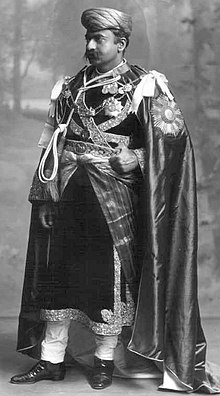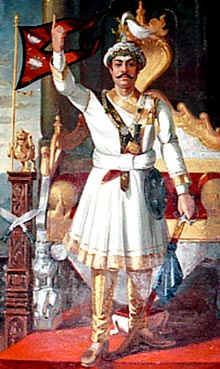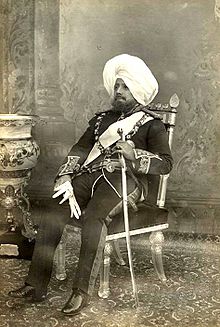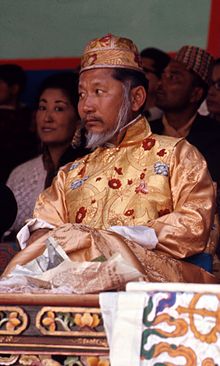Maharaja
This article needs additional citations for verification. (November 2017) |


Maharaja
The form "Maharaj" (without "-a") indicates a separation of noble and religious offices, although since in
It's variants include Maharana and Maharao.
Etymology
The word Maharaja originates in Sanskrit and is a compound karmadhāraya term from mahānt- "great" and rājan "ruler, king"). It has the Latin cognates magnum "great" and rex "king".[4][5] Due to Sanskrit's major influence on the vocabulary of most languages in Greater India and Southeast Asia, the term Maharaja is common to many modern Indo-Aryan and Dravidian languages. The Sanskrit title Maharaja was originally used only for rulers who ruled a considerably large region with minor tributary rulers under them. Since medieval times, the title was used by (Hindu) monarchs of lesser states claiming descent from ancient Maharajas.
Indian subcontinent
Raja as a ruler's title
On the eve of
The
The word Maharaja may be understood simply to mean "ruler" or "king", in spite of its literal translation as "great king". This was because only a handful of the states were truly powerful and wealthy enough for their rulers to be considered 'great' monarchs; the remaining were minor princely states, sometimes little more than towns or groups of villages. The word, however, can also mean emperor in contemporary Indian usage.
The title of Maharaja was not as common before the gradual British colonisation of India, upon and after which many
- Variations of this title include the following, each combining Maha- "great" with an alternative form of ).
- Maharajah has taken on new spellings due to the time change and migration. It has even been shortened to Mahraj and Maraj but the most common is Maharajah and Maharaj.
- Despite its literal meaning, unlike many other titles meaning Padshah (of Persian origin), notably applied to the Mughaldynasty, the Paramount power until the British established their raj.
|
|
|
|
Compound and dynastic ruler titles
- Dharma-maharaja was the devout title (compare Rajadharma) of the rulers of the Ganga dynasty.
In the Mughal Empire it was quite common to award to various princes (hereditary or not) a series of lofty titles as a matter of protocolary rank. The British would, as paramount power do the same. Many of these (see also above) elaborate explicitly on the title Maharaja, in the following descending order:
- Maharajadhiraja Bahadur (or Maharajadhiraj Bahadur): Great King over Kings, a title of honour, one degree higher than Maharajadhiraja.
- Maharajadhiraja (or Maharajadhiraj): Great King over Kings, a title of honour, one degree higher than Sawai Maharaja Bahadur.
- Sawai Maharaja Bahadur: a title of honour, one degree higher than Sawai Maharaja. (the term bahadur, originally 'brave' in Persian, was often used for 'one-degree' higher', and 'sawai' is 'one and a quarter higher', i.e. just a step above bahadur)
- Sawai Maharaja: a title of honour one degree higher than Maharaja Bahadur; as granted (directly) to the Rajas of Ajaygarh.
- Maharaja Bahadur: a title of honour, one degree higher than Maharaja.



Furthermore, there were various compound titles simply including other princely styles, such as:
- Maharaja Chatrapati in Satara, the paramount state of the Maratha Confederacy
- H.H. the Maharaj Rana of Jhalawar
- Maharaja-i-Rajgan: great prince amongst princes
- Maharaja Marathastate
- Maharaj Babu: A Rajput title similar to Maharaja. Used by the ruling Chiefs of Hazari Estate, Dohazari of South Chittagong.
- For details concerning various titles containing sahib, see there
Certain Hindu dynasties even came to use a unique style, including a term which as such is not of princely rank, e.g.
Chakravarti
Chakravarti is a Sanskrit term for "emperor". The meaning of chakravarti is "he, whose wheels of chariot is moving" which symbolises that the leader who is a war hero, who commands over vast land and sea, the one who rules the people with dedication. In the Mahabharata, the Chakravarti Bharat is known to have ruled the entire sub-continent of India brought golden age to his empire. He is called as chakravarti. The wife of a Chakravartin is called a Chakaravartini.
Yuvaraja
Yuvaraja means the crown prince of the kingdom or empire. He is granted with certain powers and responsibilities so that he can be prepared to take over as the Maharaja. His wife is called Yuvarani.
Rajakumara
Rajakumara is the son of a king who is not the heir apparent. He is conferred with certain duties or powers per the king's wishes. The daughter of a king is called Rajakumari.
Maharani
Maharani usually denotes the wife of a Maharaja (or Maharana, Maharao, Maharawal) or in rare cases, in some states where it was customary, a woman ruling without a husband.[6]
Rajamata
In case a child king is crowned, the mother of the king takes charge of the kingdom and acts as a regent. Until the young king is of the age, the
Noble and honourary use
Like Raja and various other titles, Maharaja was repeatedly awarded to notables without a princely state, such as zamindars.
- One Raja of Lambagraon, a Jagir (in Himachal Pradesh) who served in the colonial army was granted personally the non-hereditary title of Maharaja of Kangra-Lambagraon and a personal 11-guns salute, so neither honour passed on to his son and heir.
- In the major, Muslim realm of Maharaja Sir Kishen Pershad, held such a Maharaja-title.
Derived style for princes of the blood
Maharaj Kumar (or Maharajkumar) means son of a Maharaja or Heir-Apparent; the female equivalent is Maharaj Kumari (Maharajkumari): daughter of a Maharaja.
Nepal
The Gorkha
Southeast Asia
Dali
Duan Xingzhi, the last monarch of the
Indonesia
When the
Maharaja was also part of the titles of the nobility in the Sumatran sultanate of Aceh. In the past, the title of Maharaja is given to a leader of the unreigning noble family and the Prime Minister Maharaja Mangkubumi. The last Prime Minister of Aceh who was installed to be the Maharaja Mangkubumi, Habib Abdurrahman el Zahir, who also acted as the foreign affairs minister of Aceh but was deposed and exiled to Jeddah by the colonial Dutch East Indies authorities in October 1878.
Malaysia
In peninsular Malaysia:
- Maharaja was the title of the monarch of the peninsular Malay state of Johor(e) from 1873 to 1885. The Arabic, Muslim title Sultan, often considered of higher rank, was re-adopted later and remains in current usage.
- The title Bendahara Seri Maharaja was used by the ruler of Pahang (1623–1853 in personal union with Johor, eventually becoming a fief of the Bendahara family), till on 6 August 1882 Tuanku Ahmad al-Muadzam Shah ibni al-Marhum Tun Ali adopted the title, Sultan.
In northern
The Englishman Capt.
In contemporary Malay usage, the title Maharaja refers to an emperor, e.g. "Maharaja Jepun" ("Emperor of Japan").
Brunei
In Seri Malayas of the
Compound Malay titles
The word can also be part of titles used by Malay nobility:
- Maharaja Lela was the title of the ruler of the State of Naning (founded 1641), until it was annexed by the United Kingdom to Malacca in 1832.
Most famous was
The
Eventually, Maharajah Adinda was also used to refer to a particular lineage within the royal families.
Thailand

The
See also
Notes
References
- ^ "Maharaja". Oxford English Dictionary (Online ed.). Oxford University Press. (Subscription or participating institution membership required.)
- ISBN 81-7022-251-6.
... Literally Maharaja means 'a great king' ...
- ^ "Maharaja | Hindu title". Encyclopædia Britannica. Retrieved 17 April 2021.
- ^ Thomas J. Samuelian (2000), Armenian origins: an overview of ancient and modern sources and theories, Iravunq Publishing House,
... Cognate Chart Sanskrit: Maha Greek: Mega English: Much ...
- ^ Horace G. Danner, Roger Noël, An introduction to an academic vocabulary: word clusters from Latin, Greek and German,
... Mag-, great; maj-, greater; max-, greatest; IE base: meg-, yields Sanskrit maha; English much; Greek mega ...
- ISBN 1-900269-20-1.
- ^ "Sethu Lakshmi Bayi, The Feminist Queen of the House of Travancore". Thebetterindia.com. 27 October 2016. Retrieved 17 April 2021.
- ^ Srinivas, Pendem (14 March 2016). "Rudramadevi History, Achievements and Administration". Indiathedestiny.com. Retrieved 17 April 2021.
- ^ "Rajmata Jijau Birthplace, Sindkhed Raja | District Buldhana, Government of Maharashtra | India". Buldhana.nic.in. Retrieved 17 April 2021.
- ^ Yang, Bin (2008a), "Chapter 3: Military Campaigns against Yunnan: A Cross-Regional Analysis", Between Winds and Clouds: The Making of Yunnan (Second Century BCE to Twentieth Century CE), Columbia University Press
- ^ P. J. Rivers, "The Origin of 'Sabah' and a Reappraisal of Overbeck as Maharajah", Journal of the Malaysian Branch of the Royal Asiatic Society 77(1), 2004; pp. 79–80








